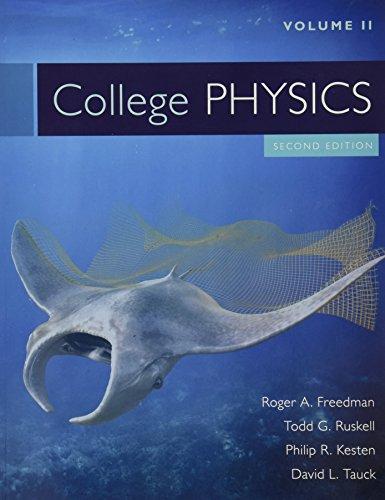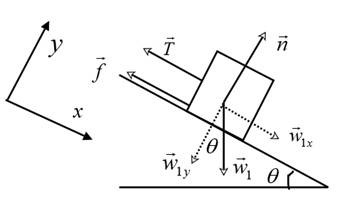
Concept explainers
The magnitude of the tension in the string which connects two blocks, one of which hangs vertically down and the other resting on an inclined plane.
Answer to Problem 79QAP
The tension in the string is found to be 3.92 N.
Explanation of Solution
Given info:
Mass of the block placed on the incline
Mass of the hanging block
Angle made by the plane with horizontal
Coefficient of static friction
Coefficient of kinetic friction
Formula used:
Free body diagrams are drawn for the two blocks and the tension in the string is determined using the force equations for both the blocks.
The free body diagram for the block of mass
The weight of the block is

The total force acting along the +x direction is given by,
Draw the free body diagram for the block of mass

The weight
Resolve the weight
The force equation along the +x direction is given by,
The force equation along the +y direction is given by,
Since the block is in equilibrium in the y direction,
Hence,
The force of friction and the normal force are related as follows:
The value of the coefficient of friction
Calculation:
The system would be at rest, if the following conditions are satisfied:
and
If
Since
Substitute the values of the variables in the above equation,
To check whether the system is at rest, use the expression
Therefore,
Calculate the value of
The component
Therefore,
Use the values of the variables in the equation.
If the system is at rest, assume the maximum force of static friction to act on the block.
Then,
From equation (4),
The component
Calculate the maximum force of static friction acting on the block.
It can be seen that
Conclusion:
Since the system is at rest, the force of tension in the string is equal to 3.92 N.
Want to see more full solutions like this?
Chapter 5 Solutions
College Physics Volume 2
- During a storm, a tree limb breaks off and comes to rest across a barbed wire fence at a point that is not in the middle between two fence posts. The limb exerts a downward force of 292 N on the wire. The left section of the wire makes an angle of 10.5° relative to the horizontal and sustains a tension of 412 N. Find the (a) magnitude and (b) direction (as an angle relative to horizontal) of the tension that the right section of the wire sustains.arrow_forward2) A cat with a mass of {04} kg is at rest on a roof at an angle of 34° from horizontal. The coefficient of static friction between cat paws and roof tiles is 0.70, and gravity is 10 N/kg today. a) Draw a Force Body Diagram of the cat, labelling and calculating all forces. b) Draw a 2nd FBD of the cat if the angle of the roof was 74° from horizontal (steeper). Will the cat be able to stay on the roof at this angle? Justify with calculations why or why not? c) If the coefficient of kinetic friction between cat and roof were zero, what would be the cat’s acceleration on the 74° roof?arrow_forwardQ4;The figure below shows a box with a mass of m = 2.70 kg on a surface inclined at an angle of 35.0°. The coefficient of static friction between the box and the surface is 0.275. Find the minimum magnitude of the force F (in N), applied to the box in a direction perpendicular to the surface, that will prevent the box from sliding down the surface. A rectangular box of mass m is positioned on an inclined surface of angle 35.0° (measured counterclockwise from the horizontal). A force, vector F, is applied down and right on the box, perpendicular to the incline.arrow_forward
- 1. Explain why the following situation is impossible. Your 3.80 kg physics book is placed next to you on the horizontal seat of your car. The coefficient of static friction between the book and the seat is 0.650, and the coefficient of kinetic friction is 0.550. You are travelling forward at 72.0 km/h and you hit the brakes to a stop with a constant acceleration over a distance of 30.0 m. Your physics book remains on the seat rather than sliding forward onto the floor.arrow_forwardThe 118-lb force P is applied to the 250-lb crate, which is stationary before the force is applied. Determine the magnitude and direction of the friction force F exerted by the horizontal surface on the crate. The friction force is positive if to the right, negative if to the left. Assume ??= 0.48, ??= 0.38.arrow_forwardA 10.0 kg box rests on a horizontal floor. The coefficient of static friction is 0.40 and the coefficient of kinetic friction is 0 30. Determine the force of friction, acting on the box if a horizontal applied force is exerted on it of magnitude: (A) 0, (B) 10 N, (C) 20 N, (D) 38 N, and (E) 40 N.arrow_forward
- an adventurous archeologist crosses between two rocks cliffs, with a ranging river far below, by slowly going hand over hand along a rope stretched between the cliffs. He stops to rest at the middle of the rope. The rope will break if the tension in it exceeds 3.00 x 10⁴N, and our heros mass is 81.6 kg. a. if the angle that the rope makes with the cliff is 75°find the tension in the rope. b. What is the smallest value the angle can have if the rope is not to break?arrow_forwardThe citizen's car is a 1700-kg Mercedes-Benz 300SL. The citizen manages to park his car next to the express on a highway that rises 15* above the horizontal. The coefficient of kinetic friction between the tires of the car and the road is 0.14. (a) Calculate the magnitudes of the normal forces and the static friction force exerted by the soil on the tires. (b) If at the moment the brakes that hold the car at rest give way and the car begins to move downhill, determine the acceleration and average force with which the car reaches the end of the hill.arrow_forward9 - The force F applied to an object with a mass of 4 kg on a horizontal plane gives an acceleration of 5 m / s2. Since the friction coefficient between the body and the acceleration is 0.25, how many N is the force F?A) 45B) 15C) 25D) 20E) 30arrow_forward
- A beaver drags a 7.5 N tree limb across a bumpy ground applying a force of 6.0 N at an angle of 25 degrees to the horizontal. The limb moves to the right experiencing a force of friction of 4.0 N. a) What is the vertical component of the beaver's force? b) Calculate the Normal force on the limb. c) Calculate the acceleration of the limb (do not forget the direction). d) Calculate the coefficient of friction.arrow_forward55. Subject :- Physics You are designing a high-speed elevator for a new skyscraper. The elevator will have a mass limit of 2400 kg (including passengers). For passenger comfort, you choose the maximum ascent speed to be 18.0 m/s, the maximum descent speed to be 10.0 m/s, and the maximum acceleration magnitude to be 3.30 m/s2. Ignore friction. What is the minimum value of a 60.0-kg passenger’s apparent weight during the ascent?arrow_forwardAn 80-kg block rests on a horizontal plane. Find the magnitude of the force P required to give the block an acceleration of 2.5m/s² to the right. The coefficient of kinetic friction between the block and the plane is μk = 0.25.arrow_forward
 Principles of Physics: A Calculus-Based TextPhysicsISBN:9781133104261Author:Raymond A. Serway, John W. JewettPublisher:Cengage Learning
Principles of Physics: A Calculus-Based TextPhysicsISBN:9781133104261Author:Raymond A. Serway, John W. JewettPublisher:Cengage Learning
